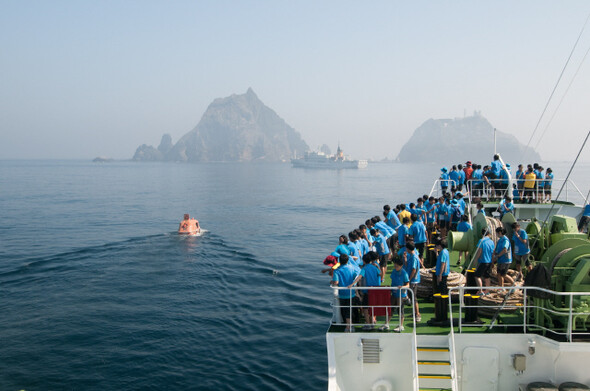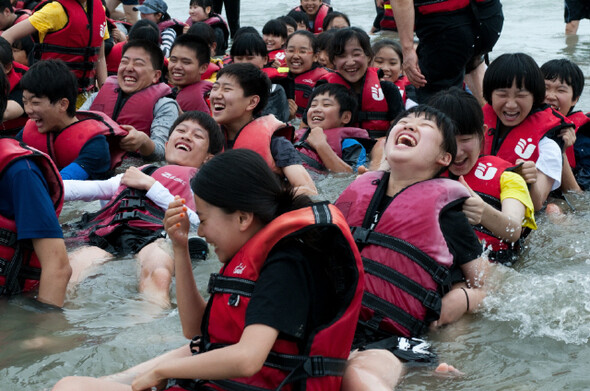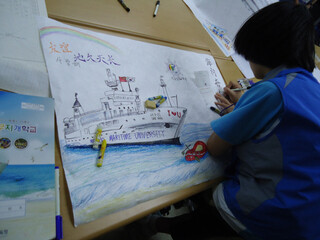hankyoreh
Links to other country sites 다른 나라 사이트 링크
[Reportage] Students from Korea and China form friendships over the high seas

By Ahn Gwan-ok, Gwangju correspondent
In early August, about 200 middle school students from South Korea and China participated in a three-week program to teach them about friendship and leadership. What did they learn from these three weeks on a boat?On August 4 some South Korean and Chinese middle school students started making a commotion when they arrived at Yamajato Elementary School in Nagasaki, Japan. Photos displayed at the school showed terrible scenes of the school devastated by a US nuclear bomb in 1945. Kim Jae-hyeon, 14, from Jangheung Middle School in South Jeolla Province, said, “I don’t understand why so many children had to be killed at that time.”
It was near the end of the Second World War when a plutonium atomic bomb was dropped on Nagasaki at 11:02am on August 9, 1945. It caused extraordinary damage to the city: out of the city’s population of 240,000, 73,884 people were killed and 74,906 were injured (accounting for almost 62%).
Yamajato Elementary School is only 600m away from the bombing’s ground zero. 1,300 out of 1,600 students were killed on that day, even though many students had not come to school after having been warned in advance about a possible bombing. Most of those students were at home when they died.
There were several symbols that illustrated the tragedy of war and the importance of peace: three bomb shelters, constructed at that time, a library with information about the bombing, and a peace bell. There was also a statue of a little girl, constructed by survivors to commemorate their classmates who passed away.

216 middle school students from South Korea and 10 from China had somber expressions on their faces after thinking of those who died at ages even younger than theirs. Shim Eun-kyung from Okgua Middle School in Gokseong, said, “This is shocking. I will tell my friends and family when I get back to Korea”.
A day before their visit to the elementary school, the students had a chance to go on a pilgrimage to some of the meaningful sites, including a memorial peace statue, an exhibition hall related to the nuclear bombing, a memorial stone for Korean victims. They were all dumbfounded by the misery caused by one nuclear bomb.
Displays at the exhibition hall included melted finger, children’s lunchboxes that were charred to resemble lumps of charcoal, broken clocks showing the time of the explosion. The students particularly seemed to be sad about the destiny of the Korean victims who were forcefully conscribed to Japan but ended up becoming a victim of the nuclear bomb.
Lee Ji-soo, from Okgok Middle School in Gwangyang, said, “I want to become a diplomat and add my strength to establishing a peaceful world so tragedies like the ones in Hiroshima or Nagasaki won’t happen again”.
Wang Minran, a female Chinese student from Yuhua Qinqin School in Hangzhou, said she was impressed by the hundreds of paper cranes displayed across the streets, schools, parks, and cathedrals in Nagasaki. A girl who developed leukemia due to the aftereffects of the nuclear bomb believed making 1,000 paper cranes would cure her disease. She died after making only 600 of them. Since then Japanese people from other provinces have made paper cranes and sent them to Hiroshima and Nagasaki as a gesture of peace.
Gang Sang-cheol, a teacher at Nampyeong Middle School in Naju, who led students during the trip, said, “It was my impression that Japan intends to emphasize their own victimhood. This appears as if they are not making full apology to the past history and their own accountability for the cause of such incident. The real peace only comes from sincere self-reflection”. Kim also said, “If Japan did not invade neighboring countries, the children wouldn’t have to be killed. A country’s wrong decision does nothing but victimize their own people”.
The students who were on the peace pilgrimage are participants in the ‘Maritime Rainbow School’, organized by South Jeolla Province Office of Education between July 21 and August 10. The 3-week trip went for 1,071 miles of international sea and 844 miles of coastal sea, 1,915 miles (3,546km) in total. It gave students a chance to go a boat tour and learn about peace, while experiencing new nature and culture.
The students initially underwent 4 days of basic training at Songho students’ training camp in Haenam County, South Jeolla Province. After that they boarded the Saenuri boat (4700t) and Saeyudal boat (3500t), provided by Mokpo National Maritime University. The trip included a 6-day trip to Ulleungdo and Dokdo islands, as well as a 10-day trip to Nagasaki and Shidao, Shandong Province in China.
The students on the boat shared true friendship regardless of nationality. The shadows of East Asia historical disputes or territorial disputes were nowhere to be seen.
Kim In-soo, a student at Isu Middle School in Suncheon, said, “As the Chinese students study at international schools, they speak English well and are good at drawing pictures and writing”.
Guo Zhaoyi, a male Chinese student, said, “I see no difference among Chinese people, Korean people and Japanese people after having met them all. If young students like us can have more chances to be on board together, we will probably be able to share deeper, more peaceful friendship”.

Liu Jing, a female teacher from China, said, “I was surprised by the Korean students as they followed the rules consistently and actively participated in both classes and games. It must have positively stimulated our Chinese students.”
The friendship among the Korean and Chinese students had become so deep that they showed tears when saying farewell to each other on 8 August at Shidao port. The original plan included 10 students participating from Zhejiang Province in China, and 10 students from Saga Prefecture in Japan. However, the Japanese students withdrew their plan to join the trip in protest against the plan to visit Dokdo.
While the boats darted across the blue sea around the Korean peninsula, students had a series of field studies and group activities. For example, on-duty experience on board, foreign language learning, flash mob on the deck, UCC (User Created Contents) production, flying balloon, cross-cultural learning and so on. Though the students could not avoid becoming somewhat seasick and tanned under the strong sun, it was not difficult to find students satisfied and proud of themselves for having successfully completed the 3-week journey.
Cho Hyung-gyu, from East Gure Middle School, who grew up in the Jiri mountain area, said, “Staying on a ship wasn’t easy or comfortable. But I realized the world is big”. Kim Min-joon, from Hampyeong Middle School, whose dream is to become an architect, said, “I have a strong interest in wooden buildings. In that sense, it was a good opportunity for me to look carefully the different styles of wooden buildings in China and Japan”.
During the time they spent together on the boat, students were frequently reminded that they are one group sharing a common destiny on the same boat. Students were chosen based on three different specialties: academic excellence, exemplary behavior, and social consciousness. Despite the students’ different characteristics, on the boat they showed no signs of conflict and naturally accepted each other.
They had some luck in seeing sea life at a close distance: on July 27 a group of 40 dolphins was spotted around Dokdo. Im yeong-seo, a 15-year-old female student from Keumil Middle School in Wando, said, “I still clearly remember the beautiful scenery of dolphins swimming swiftly altogether”. On August 2 a flying fish suddenly jumped on the boat around Nagasaki, which excited the students.
Vice Principal for the Maritime Rainbow School Park Jeong-soo was proud of his students by saying, “I see them growing up quickly as they come to respect each other”.
South Jeolla Office of Education has hosted four Maritime Rainbow School programs since 2011 with 764 students participating in total. The unprecedented support and fresh contents of the program are the key reasons why its popularity has been growing among students, parents, and teachers.

On the other hand, there are some who criticize the program as it is not so cost-effective, especially considering its large budget, but relative lack of quality programs. The Maritime Rainbow School program cost 2.2 billion won to operate in 2011, 1.7 billion won in 2012 and 1.5 billion won in 2013. This amounts to a 2013 per student cost of 6 million won.
This was often pointed out during a parliamentary audit. The critics say, ‘Since it requires a large budget, a typical ambiguous slogan like “promoting global leaders” cannot be accepted. Themes and itinerary must be stated specifically and thoroughly planned. It also must organize international programs properly’.
Jang Man-chae, Superintendent of South Jeolla Province Education Office said, “This is a special policy attempting to foster young people who can lead South Jeolla Province and Korea 30 or 40 years from now. This program is praised by the other regions, too. If we can provide an opportunity to broaden their horizons for our next young leaders, it is certainly a worthwhile investment”.
The students’ boats departed Mokpo on July 1 and reached Nagasaki on August 2, and Shidao on August 6. It then safely came back to Mokpo on August 10.
Translated by Lee Dong-ju, Hankyoreh English Intern
Please direct questions or comments to [english@hani.co.kr]

Editorial・opinion
![[Column] Season 2 of special prosecutor probe may be coming to Korea soon [Column] Season 2 of special prosecutor probe may be coming to Korea soon](https://flexible.img.hani.co.kr/flexible/normal/500/300/imgdb/original/2024/0426/3317141030699447.jpg) [Column] Season 2 of special prosecutor probe may be coming to Korea soon
[Column] Season 2 of special prosecutor probe may be coming to Korea soon![[Column] Park Geun-hye déjà vu in Yoon Suk-yeol [Column] Park Geun-hye déjà vu in Yoon Suk-yeol](https://flexible.img.hani.co.kr/flexible/normal/500/300/imgdb/original/2024/0424/651713945113788.jpg) [Column] Park Geun-hye déjà vu in Yoon Suk-yeol
[Column] Park Geun-hye déjà vu in Yoon Suk-yeol- [Editorial] New weight of N. Korea’s nuclear threats makes dialogue all the more urgent
- [Guest essay] The real reason Korea’s new right wants to dub Rhee a founding father
- [Column] ‘Choson’: Is it time we start referring to N. Korea in its own terms?
- [Editorial] Japan’s rewriting of history with Korea has gone too far
- [Column] The president’s questionable capacity for dialogue
- [Column] Are chaebol firms just pizza pies for families to divvy up as they please?
- [Column] Has Korea, too, crossed the Rubicon on China?
- [Correspondent’s column] In Japan’s alliance with US, echoes of its past alliances with UK
Most viewed articles
- 1[Column] Season 2 of special prosecutor probe may be coming to Korea soon
- 2No good, very bad game for Korea puts it out of Olympics for first time since 1988
- 3‘We must say no’: Seoul defense chief on Korean, USFK involvement in hypothetical Taiwan crisis
- 4Division commander ordered troops to enter raging flood waters before Marine died, survivor says
- 5Is Japan about to snatch control of Line messenger from Korea’s Naver?
- 6Korea’s 1.3% growth in Q1 signals ‘textbook’ return to growth, says government
- 7Is N. Korea threatening to test nukes in response to possible new US-led sanctions body?
- 8[Editorial] Korea’s surprise Q1 growth requires objective assessment, not blind fanfare
- 9[Editorial] New weight of N. Korea’s nuclear threats makes dialogue all the more urgent
- 10[Editorial] In the year since the Sewol, our national community has drowned